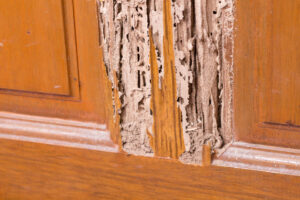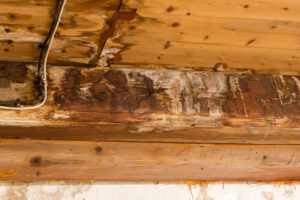It’s every homeowner’s nightmare scenario – looking at a windowsill, cutting into a wall panel, or pulling up a piece of flooring to see the telltale tracks and tunnels of termites chewing through your home. By the time even one clue is evident, at least minor damage has already been done, and homeowners usually aren’t aware of termites until they’ve suffered at least a moderate amount of damage.
However, not all is lost. While the Formosan termite, the bane of the Pacific Northwest and the southeastern US alike, can completely gut a home in just a few years, they generally make themselves known long before the damage is irrecoverable. Other termite species build smaller colonies and could take up to 20 years to do enough damage to render the home unrepairable.
Long story short, you will probably be able to restore your home to livable condition, but it will take time, effort, and expense. If you’re not a skilled DIYer with experience building and repairing structural elements of a house, you will need to involve a contractor or carpenter to handle some or all the repair work.
Here are the basic steps to returning your home to shape after a termite infestation.
Step 1: Get Rid of the Termites
There’s no point in proceeding with repairs until you’re 100% certain that every termite has been eradicated and that an effective termite-prevention solution is in place. Otherwise, your repairs will be a buffet for the next generation of insects.
Contact a licensed exterminator, who will first use a termite treatment like Termidor, which penetrates the soil surrounding a colony and spreads from termite to termite, quickly killing all the insects. Following that, a termite preventative like Sentricon will prevent future termite swarms from settling near your home.
Only after your termite treatment has been completed and your termite preventative is in place should you proceed to step 2.
Step 2: Assess the Termite Damage
If you’re lucky, the termites were detected before they got into the structural members of your home – the sill, floor joists, subfloor, plates, wall studs, and ceiling and roof structures. If the only wood that the termites have attacked is surface or cosmetic, like siding, decking, or trim, you may be able to replace all of the damaged wood yourself without hiring a contractor, depending on your DIY prowess.
The repair will be considerably more complicated if the termites have gotten into the home’s structure. Even properly accessing the damage may require removing interior drywall or plaster, flooring, fixtures, cabinets, windows, and doors. You should only undertake this sort of work if you’re skilled in home repair and have previously done things like this.
Look at every square inch of wood for signs of termite infestation. Many homeowners confuse termite damage with water damage, so make sure you know what you’re looking for:
Termite Damage:
Termites leave hollow, wavy tunnels carved into the surface of the wood, usually more-or-less following the woodgrain. You’ll see small holes in the surface of the wood, and the wood will sound hollow when you knock on it. Some types of drywood termites prefer to tunnel through the center of wood, leaving the wood swollen and hollow.

Water Damage:
When wood is water damaged, it typically either swells and splits or begins to rot. In either case, the damage will usually be accompanied by mold or mildew growth, a yellowing or darkening of the wood, and in cases of advanced rot, will begin to look like the scales on an alligator’s back. Water-damaged wood is crumbly or easy to crack when it’s dry and is spongy when it’s wet.

Once you’ve determined where the damage has occurred and its extent, it’s time to move on to step 3.
Step 3: Repair the Termite Damage
While repairing termite-damaged wood is possible, it is crucial to note that this is only an option for very lightly damaged cosmetic wood on the interior of a home. Never try to repair structural or exterior wood – this wood must either be removed entirely or supplemented by adding additional structural members alongside the damaged wood.
Repairing Damaged Wood
This option is the simplest and the only one that doesn’t require some significant skill as a carpenter. To repair the grooves and tunnels carved into the wood by the termites, fill the voids with a water-based wood filler or wood putty, let the putty dry, sand it smooth, and reapply the finish. Again, this type of repair should only be used on nonstructural, cosmetic, interior wood.
Making Larger Repairs
Surface/Cosmetic Repairs
If there’s termite damage in surface or cosmetic wood on the exterior of the home, and you’re comfortable making these repairs yourself, you can now go through the steps of removing the damage and replacing with fresh wood. Siding, trim, railings, and other components that aren’t structural can be safely replaced without affecting your home’s strength. Note, though, that for items like siding and window and door trim, these pieces may affect the home’s watertightness, so make sure any new wood is properly painted, caulked, and sealed. If you’re not comfortable taking on these projects, it’s time to contact a local contractor or carpenter.
Structural Repair
If termites have damaged structural members in your home’s framing, flooring, or roof, these pieces must be replaced as soon as possible in order to restore your home’s structural integrity. If you don’t have experience removing and replacing structural members from building framing, flooring, or roofing, contact a professional. Even a small accident or error in repairing your home’s structural elements can lead to disaster.
If structural repair is necessary, contact some local carpenters or contractors and have them bid on the job. Make sure that the professional you hire is properly insured so that you’re covered in the event of any repair mishaps.
An Ounce of Prevention is Worth a Pound of Cure – Let National Exterminating Secure Your Home Against Termites and Other Pests. Call us: 478-922-1410.
National Exterminating’s full-service pest control methods can keep termites out of your home and yard. Call us today at 478-922-1410.
Related blogs:
